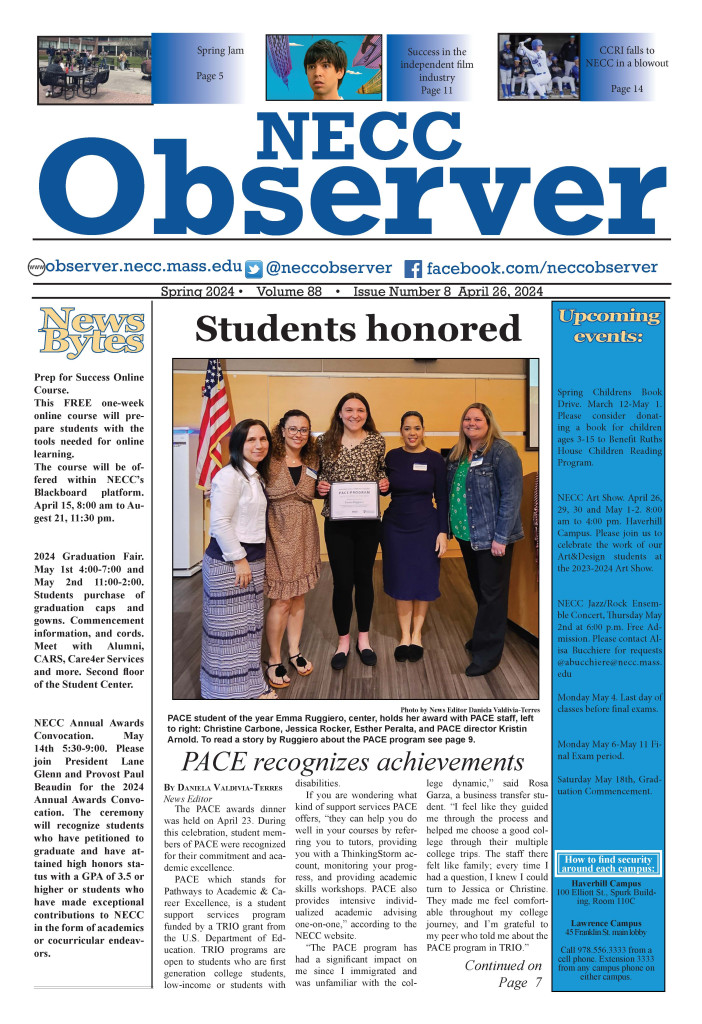Since March of this year, students have had to adjust to online learning due to the COVID-19 pandemic. But teachers and professors have had to adjust as well. While many educators at NECC have taught online classes prior to 2020, they are now forced to adjust their teaching to exclusively online, which presents its own set of challenges.
Patricia Portanova, an English professor at NECC, says, “I think the most challenging part is creating engagement and connections with students. Because we aren’t able to actually physically be in a room together, it’s really hard to get a sense, I think, of personality, a sense of good will, because so much of our interaction is through text on a screen or brief videos. It’s very transactional or one-way as opposed to sort of a back and forth communication between students and faculty.”
Thomas Greene, also an English professor, agrees, “The hardest part is connecting with the students. It’s just not in our nature to learn this way in the way that it is in our nature to learn from a live person in the same location,” he said.
Greene further explains that humans struggle to learn online due to socio-biology and evolution. “Humans evolve in certain environments, and then the behaviors that we feel comfortable with are based on what our ancestors did,” he said. “And so ancestrally, humans have been communicating face-to-face for 200-300,000 years in some form of language. Writing is a relatively new technology, only about 6,000 years old. If someone wants to learn something, like a practical skill, wood working, or yoga, they don’t want to learn it from a book. They want to learn it from a person who can demonstrate and explain and answer questions and coach.”
The challenges for educators are not felt at just the college level. Teachers with younger classes feel pressure as well. Brendan Molloy, an eight grade English Language Arts and Civics at Hunking School in Haverhill, is working under a hybrid learning model with students spending two days a week in school and three days learning remotely.
Molloy describes it as, “On a given day, I’ll have somewhere between 9 and 15 kids in front of me and then somewhere between 9 and 15 kids at home on their computer. And so, I’m both facilitating the remote learning and teaching the kids that are present in the building and trying to maintain continuity within my units in designing active instruction for the two days that they’re with me and then more self-guided remote facilitated work for the 3 days that they’re home.”
“There are a lot of difficulties in this,” Molloy explains. “One of the major difficulties is that I have now over a decade’s worth of curriculum that I’ve designed that I’m happy with. And trying to rewrite some of my materials that are tried and true to sort of fit this new rhythm is interesting. The other thing that’s a little complex about it is trying to figure out the right balance of which content should be prioritized for in-person and what content can be left to remote.”
Molloy not only has to structure lesson plans for students, he also has to respond to feedback from his students’ parents.
One of Molloy’s challenges is, “Finding the right balance of meeting diverse student needs. I’ve heard from parents who are overwhelmed by the amount of work that I’ve given and are having a hard time keeping pace. And I’ve heard from parents who are concerned that I haven’t provided enough work to their kid and that they don’t have enough work to do in the day. That’s sort of emblematic of the difficulty in walking this tightrope of not overwhelming students with work while also providing enough rigorous material to keep parents and kids occupied and satisfied at home.”
Greene agrees with Molloy that setting up an effective curriculum is critical for student success, “A big part, I think, is course design. The course has to be set up in such a way that it’s not creating an additional obstacle. The learning is already hard enough. Creating more obstacles in the way is just making it worse.”
All three educators agree that a key to success for both students and teachers is effective time management.
“I think that self-time management has been really challenging for students, and for faculty, to be fair. I think the stress of the pandemic makes it really hard for anyone to think clearly, to be productive, to get organized, so I think we’re all collectively struggling with time management and getting things done,” says Portanova.
For NECC students, resources are available for those struggling not only with their classes, but for those dealing with the current learning environment itself.
Portanova explains, ““The first piece of advice I always give is to contact your faculty directly and just let them know what’s going on in your life. We are all going through a lot right now and direct communication is very important. Faculty are very empathetic towards students’ situations and what they’re going through and so if you can just let faculty know that you are struggling, they’re going to do their best to help you. The second piece of advice, I would say, is to take advantage of our student support services. Academic coaching is fantastic. They’re amazing at supporting students who are struggling with time management and getting work done. We have writing tutors, ESL tutors, we have fantastic librarians. We have excellent counseling services on campus. We have basically any type of student support you can think of. And everyone is here to help students be successful.”

